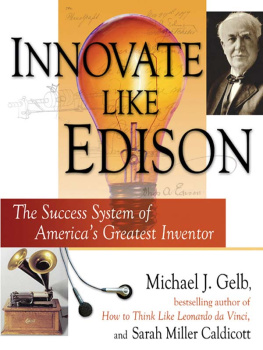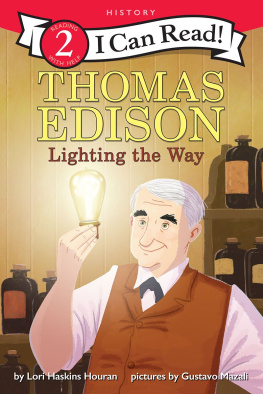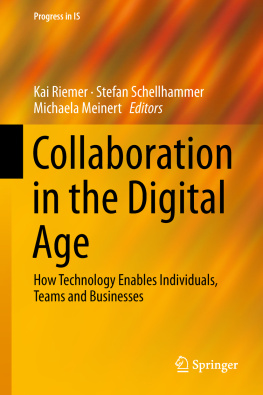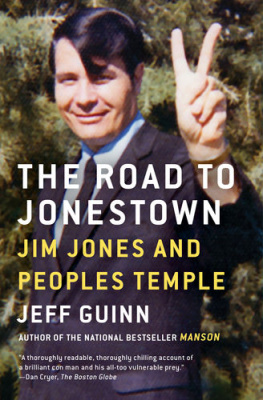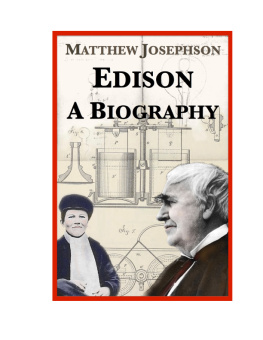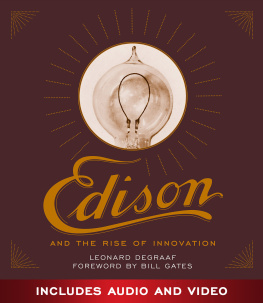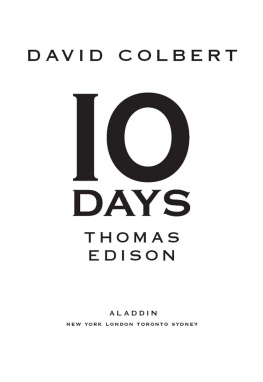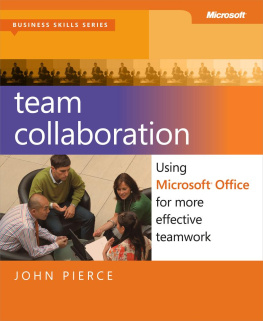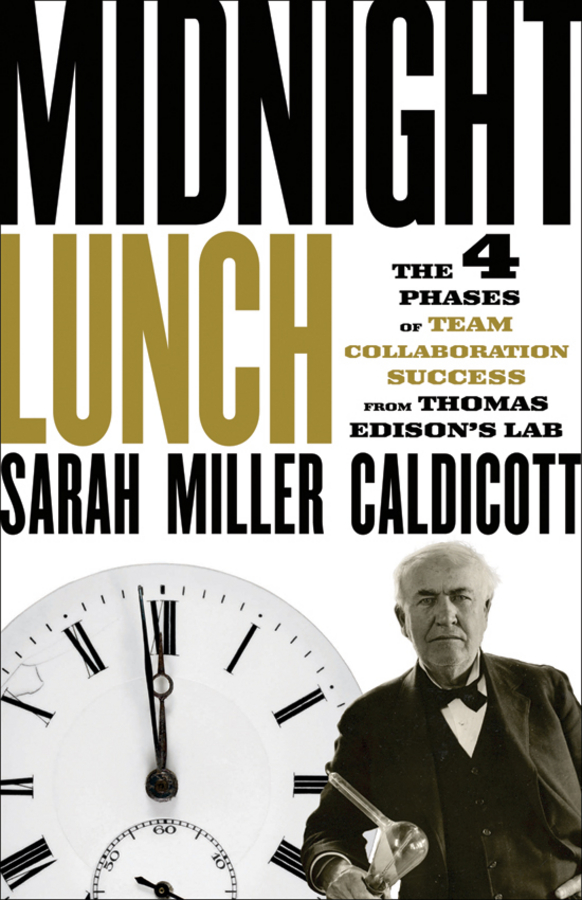Contents

Cover image: Clock: Daniel Sanchez Blasco/iStockphoto; Thomas Edison: Courtesy of National Park Service, Edison National Historic Site.
Cover design: C. Wallace
Copyright 2013 by Sarah Miller Caldicott. All rights reserved.
Published by John Wiley & Sons, Inc., Hoboken, New Jersey.
Published simultaneously in Canada.
Thomas Edisons Five Competencies of Innovation is a registered trademark of Sarah Miller Caldicott 2007.
Thomas Edisons Four Phases of True Collaboration is a registered trademark of Sarah Miller Caldicott 2012.
No part of this publication may be reproduced, stored in a retrieval system, or transmitted in any form or by any means, electronic, mechanical, photocopying, recording, scanning, or otherwise, except as permitted under Section 107 or 108 of the 1976 United States Copyright Act, without either the prior written permission of the Publisher, or authorization through payment of the appropriate per-copy fee to the Copyright Clearance Center, Inc., 222 Rosewood Drive, Danvers, MA 01923, (978) 750-8400, fax (978) 646-8600, or on the web at www.copyright.com . Requests to the Publisher for permission should be addressed to the Permissions Department, John Wiley & Sons, Inc., 111 River Street, Hoboken, NJ 07030, (201) 748-6011, fax (201) 748-6008, or online at http://www.wiley.com/go/permissions .
Limit of Liability/Disclaimer of Warranty: While the publisher and author have used their best efforts in preparing this book, they make no representations or warranties with respect to the accuracy or completeness of the contents of this book and specifically disclaim any implied warranties of merchantability or fitness for a particular purpose. No warranty may be created or extended by sales representatives or written sales materials. The advice and strategies contained herein may not be suitable for your situation. You should consult with a professional where appropriate. Neither the publisher nor author shall be liable for any loss of profit or any other commercial damages, including but not limited to special, incidental, consequential, or other damages.
For general information on our other products and services or for technical support, please contact our Customer Care Department within the United States at (800) 762-2974, outside the United States at (317) 572-3993 or fax (317) 572-4002.
Wiley publishes in a variety of print and electronic formats and by print-on-demand. Some material included with standard print versions of this book may not be included in e-books or in print-on-demand. If this book refers to media such as a CD or DVD that is not included in the version you purchased, you may download this material at http://booksupport.wiley.com . For more information about Wiley products, visit www.wiley.com .
ISBN: 978-1-118-40786-8 (cloth)
ISBN: 978-1-118-41785-0 (ebk)
ISBN: 978-1-118-42196-3 (ebk)
ISBN: 978-1-118-43447-5 (ebk)
With deepest love to my husband, Wayne
When you honor me, you are also honoring the vast army of workers but for whom my work would have gone for nothing .
Thomas Alva Edison
Foreword
I first met Sarah following a speech she delivered in 2011 at a high-level innovation leadership conference hosted by Kraft. I was immediately struck by the relevance of her teachings. As a cofounder of Brightidea, a company that focuses on tools to harness innovation, I was captivated by Sarahs presentation. Her understanding of innovation practices used by Thomas Edison, and the links between those practices and todays urgent need to continually innovate, sheds light on how some of the worlds most revolutionary inventions came to be. And critically, how Edisons practices might be successfully contemporized and translated today.
In Midnight Lunch , Sarah brings Edisons timeless collaboration formula to the fore. She advances our understanding of the rapidly changing innovation environment by providing deep insight into Edisons proven collaboration processes. Importantly, her teachings allow innovation practitioners to apply those proven practices in the digital era. Sarah notes that Edison emphasized collaboration as a discovery learning process, which served as the backbone of his innovation efforts. Rather than adopting a classroom-focused or task-focused orientation, collaboration for Edison was highly hands on, experiential, and project-driven. His teams learned through interaction with their colleagues, allowing them to unlock their own innate creativity and enhance ideas through collaborative adaptation. Sarah shows us how to inject Edisons undeniably brilliant insight into the collaborative process.
Sarahs insights could not come at a better time. Those companies that successfully innovate continue to flourish. But companies that fail to innovate risk their very survival. Almost 50 percent of companies that made the 1999 Fortune 500 list (238 companies to be exact) were absent from the 2009 list due to dramatic falls in revenues. Extend that history, and the results become even more onerous: only 71 companies listed as part of the original 1955 Fortune 500 have survived to grace todays 500. The world has become a tougher place, and the corporate playing field is littered with companies that failed to make the grade through successful innovation. I think of Blockbuster, Eastman Kodak Company, Borders, and Hostess Brands as recent examples. To survive, companies can no longer rely on past successes. Rather, surviving in an ever-changing global economy requires continual, effective, culturally embedded innovation and collaboration approaches.
Sarah describes Edisons collaboration process as being composed of four interlocking phases: capacity, context, coherence, and complexity. One thread running through the phases is an intriguing discussion of metalogue, a method of inquiry for exploring diverse conversations and the context around those conversations. Sarah speaks to the emerging role of technological advancements and digital links among teams around the world as a component of metalogue, allowing companies to activate innovation and collaboration in rapid and scalable ways. Sarahs comments about this process align with our own experience developing the Innovation Grid, a concept championed at Brightidea. A platform now touching almost every part of the world, the grid creates online channels of deep communication and collaboration, resulting in a marketplace of new ideas. The grid also provides methods to predictably repeat the innovation process by allowing companies to focus collaborators in many different geographies, from start-ups like Kickstarter and 99Designs, to established companies such as GE and P&G, which are fostering open innovation.
But where does collaboration come from? How do companies develop collaborative structures that help drive future brand loyalty, market share, and profitability? The innovation process is a creative activity. What Edison seems to have realized is that, first, everyone is creative and, second, that if properly nurtured, the most important assets of a companyits employees and customerscan generate a constant stream of good ideas that connect to needs. To do so, companies must develop a culture that nurtures creativity, addresses customer needs, and strives to apply the good ideas that percolate upward like so many diamonds. People can be taught to innovate. They can be taught to recognize the creative gifts that they have been given and to apply those gifts. As Edison shows us, what they need is leadership, a collegial environment, and inspired direction.


